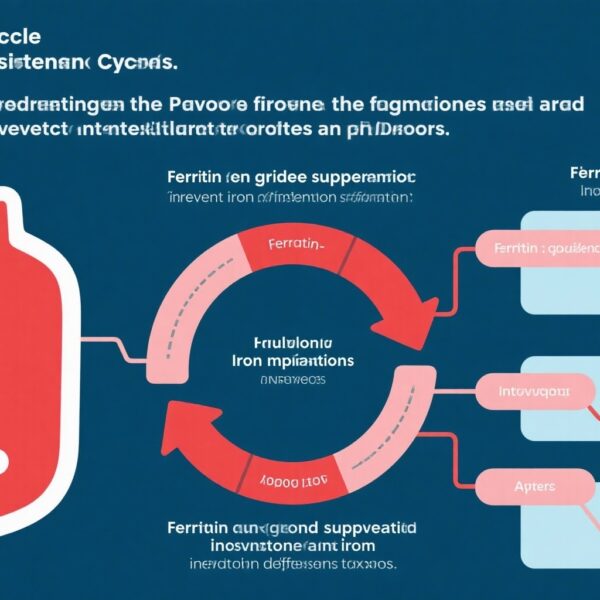Highlight
– Addition of combined L-carnitine and selenium supplementation to methimazole (MMI) therapy accelerates TSH-receptor antibody (TRAb) normalization in Graves’ disease (GD).
– The intervention group also exhibits reduced methimazole dosing requirements and a significantly higher rate of spontaneous remission.
– Although overall symptom burden was similar, supplementation independently improved severity of tremor, irritability, mood lability, heat intolerance, and exertional dyspnea.
Study Background and Disease Burden
Graves’ disease (GD) represents the most common cause of hyperthyroidism worldwide, characterized by autoimmune stimulation of the thyroid gland via TSH-receptor antibodies (TRAb), resulting in excess thyroid hormone production. Despite treatment advances, the therapeutic response to antithyroid drugs such as methimazole (MMI) remains unpredictable. Patients frequently endure persistent thyrotoxic symptoms that often poorly correlate with circulating thyroid hormone levels, complicating assessments of disease control and prolonging treatment duration. Guidelines lack consensus regarding optimal therapy length, and some patients require long-term or definitive therapy (radioiodine or surgery). Thus, identifying adjunctive strategies to improve biochemical remission rates, reduce medication exposure, and enhance quality of life (QoL) is a clinical imperative.
Preclinical data suggest that L-carnitine (LCT) can antagonize thyroid hormone action at nuclear receptors reducing hyperthyroid symptoms. Selenium (Se) is a crucial trace element with notable antioxidant and immunomodulatory effects, potentially modulating autoimmune thyroiditis progression. This study probes the hypothesis that combining LCT and Se supplements with standard MMI therapy may synergistically improve outcomes in overt GD.
Study Design
This multicenter, prospective randomized controlled trial enrolled 60 consecutive patients newly diagnosed with overt GD. Inclusion criteria entailed clinical hyperthyroidism confirmed by suppressed TSH, elevated free T3 and free T4 levels, and positive TRAb. Participants were randomized into two groups: the Control Group received standard MMI therapy alone, and the Intervention Group received MMI plus combined LCT/Se supplementation. MMI dosing was adjusted per clinical and biochemical response.
Outcomes included biochemical markers—TSH, free T3 (fT3), free T4 (fT4), and TRAb levels—measured bi-monthly for up to 24 months or until spontaneous remission or definitive therapy. Patients also completed validated symptom questionnaires evaluating typical thyrotoxic symptom frequency and severity, focusing on tremor, irritability, mood lability, heat intolerance, exertional dyspnea, and others.
Key Findings
The study revealed no significant differences between groups in the time to normalization or longitudinal trends of TSH, fT3, and fT4 levels, indicating that overt thyroid hormone control was equivalent whether or not LCT/Se were added.
| Population (n= 60) |
Control Group (n = 30) |
Intervention Group (n = 30) |
p | |
|---|---|---|---|---|
| Age (years) | 48.51 (44.66–52.38) |
48.03 (41.95–51.12) |
49.00 (43.87–54.13) |
0.804 |
| Gender (female) | 46 (76.67%) |
23 (76.67%) | 23 (76.67%) | 0.760 |
| Body Mass Index | 23.15 (22.21–24.14) |
23.47 (20.36–25.00) |
22.84 (21.56–24.20) |
0.517 |
| Smoking habit | 0.585 | |||
| Active smokers | 21 (35%) | 9 (25%) | 12 (30%) | 0.588 |
| Never smoked | 32 (53.33%) | 18 (60%) | 14 (50%) | 0.438 |
| Stopped smoking | 7 (11.67%) | 3 (15%) | 4 (20%) | 1.000 |
| TSH * (mUI/L) | 0.008 (0.008–0.010) |
0.006 (0.004–0.009) |
0.008 (0.007–0.010) |
0.184 |
| fT3 * (ng/L) | 9.39 (6.20–19.20) |
12.10 (6.12–20.00) |
8.80 (6.15–14.43) |
0.282 |
| fT4 (ng/L) | 26.82 (23.30–30.33) |
29.03 (23.53–34.52) |
24.53 (19.99–29.07) |
0.203 |
| TRAb (UI/L) | 11.89 (8.94–14.84) |
12.15 (8.71–15.79) |
11.87 (6.80–16.93) |
0.748 |
Crucially, the Intervention Group achieved TRAb negativity significantly earlier than controls (Hazard Ratio [HR] = 2.35; 95% Confidence Interval [CI]: 1.14–4.81; p = 0.016). This suggests enhanced immunological remission, potentially due to the synergistic immunomodulatory effects of selenium on autoimmunity and L-carnitine’s interaction with thyroid hormone signaling pathways.
Methimazole requirements were consistently lower in the Intervention Group, with statistically significant reductions in both average daily dose (p = 0.013) and cumulative dose over the follow-up period (p = 0.020). Reduced drug exposure has potential implications for lowering adverse event risks associated with antithyroid drugs.
| Generalized Linear Model | ||||
|---|---|---|---|---|
| Formula: RESOLUTION ~ AGE + FT4 + SMOKE + SEX + TRAB + GROUP. | ||||
| Family = binomial(logit) | ||||
| Overall Model Fit | ||||
| Null model Log Likelihood 0.025; Full model Log Likelihood 51.257 | ||||
| Chi-squared 23.767; Degrees of Freedom 6; Significance level p = 0.0006 | ||||
| Estimate | S.E. | z-Value | p-Value | |
| AGE | −0.047 | 0.030 | −1.544 | 0.123 |
| FT4 | −0.004 | 0.029 | −0.146 | 0.884 |
| SMOKE [Yes] | −1.312 | 0.825 | −1.590 | 0.112 |
| SEX [Male] | 1.152 | 0.881 | 1.308 | 0.191 |
| TRAB | −0.031 | 0.038 | −0.807 | 0.420 |
| GROUP [INTERVENTION] | 3.015 | 0.824 | 3.658 | <0.001 |
The spontaneous remission rate was significantly higher in patients receiving the combined supplement (Odds Ratio [OR] = 11.22; 95% CI: 3.35–46.11; p < 0.001), highlighting a clinically meaningful benefit in disease course modulation.
TRAb: (a) Serum TRAb (UI/L) levels over time in the two study groups.
Regarding symptom burden, overall scores did not differ substantially; however, independent analysis demonstrated that LCT/Se supplementation notably alleviated the severity of specific challenging symptoms, including tremor, irritability, mood swings, heat intolerance, and breathlessness on exertion. These improvements can considerably enhance patient well-being and daily functioning.
Expert Commentary
The addition of combined L-carnitine and selenium to methimazole therapy represents a novel, evidence-based adjunct that targets both symptomatic relief and autoimmune modulation in Graves’ disease. The earlier TRAb negativity indicates a probable modification of the underlying pathogenic process rather than symptomatic suppression alone, which is promising for long-term prognosis.
Limitations include the moderate sample size and the absence of longer-term follow-up data on relapse rates post-therapy cessation. Additionally, symptom questionnaires rely on patient self-report, which may introduce subjective variability. Generalizability requires confirmation in broader populations and with differing baseline selenium status.
Mechanistically, selenium’s role in selenoprotein-mediated antioxidant defense and immune regulation complements L-carnitine’s interference with thyroid hormone receptor activation in peripheral tissues, providing biologic plausibility to the observed clinical effects.
Existing guidelines do not routinely recommend supplementation; however, this study supports re-evaluating this position, especially considering the safe profile of both supplements and their adjunctive benefits.
Conclusion
This prospective randomized trial demonstrates that combined supplementation with L-carnitine and selenium alongside standard methimazole therapy in overt Graves’ disease leads to faster immunological remission, lower methimazole drug requirements, and improved spontaneous remission rates. While overall thyroid hormone normalization remains comparable, the adjunct confers additional benefits on specific symptom domains.
These findings suggest that incorporating LCT and Se supplements may provide a practical, low-risk strategy to enhance treatment outcomes, reduce cumulative drug exposure, and improve quality of life in GD patients. Further large-scale studies are warranted to confirm these benefits and assess long-term relapse and safety profiles.
References
1. Rossi M, Meomartino L, Zavattaro M, et al. Adding L-Carnitine and Selenium to Methimazole in Graves’ Disease: A Prospective Randomized Trial on Thyroid Markers and Quality of Life. Nutrients. 2025;17(16):2693. doi:10.3390/nu17162693 IF: 5.0 Q1 .
2. Bahn RS, Burch HB, Cooper DS, et al. Hyperthyroidism and other causes of thyrotoxicosis: Management guidelines of the American Thyroid Association and American Association of Clinical Endocrinologists. Thyroid. 2011;21(6):593-646.
3. Venturi S, Venturi M. The biochemical and physiological role of selenium and the effects of selenium deficiency in humans. J Trace Elem Med Biol. 2009;23(4):243-249.
4. Köhrle J. Selenium and the thyroid. Curr Opin Endocrinol Diabetes Obes. 2009;16(5):455-461.
5. Duntas LH, Benvenga S. Selenium: an element for life. Endocrine. 2015;48(3):756-775.
6. Köhrle J, Hagendorf K. L-carnitine counteracts nuclear thyroid hormone action in cultured rat hepatocytes. Biochem Biophys Res Commun. 1987;149(1):428-33.
7. Laurberg P, Karmisholt J, Andersen SL, Hegedüs L. Selenium supplementation in Graves’ disease and orbitopathy. Horm Metab Res. 2016;48(10):681-687.
—



